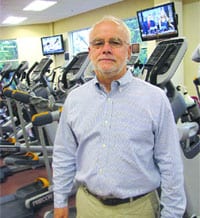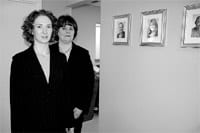Body of Work Springfield College Facility to Focus on Wellness, Research, and Quality-of-life Issues
Charles Redmond says the mission statement for Springfield College’s new Center for Wellness Education and Research, due to open in September, is still very much a work in progress.
There’s nothing down on paper yet, said Redmond, dean of the college’s School of Health, Physical Education and Recreation, and certainly nothing approved by college administrators. But some wording is being rounded into shape.
“We want to create a center that, through a focus on research and education, will explore various elements of wellness and, in the process, improve quality of life for people across the lifespan,” he said. “If can make a difference in trying to keep people healthier, whether through public policy or a domino effect, we would then be contributing to the bigger picture.”
These are ambitious goals, but, in Redmond’s mind, realistic ones as the college advances plans for the center, which will, according to those plans, conduct groundbreaking research, become a national source for the latest wellness information, and design and present public wellness-education programs and conferences.
“There is so much information on wellness or health, fitness or nutrition available today,” he explained. “The public gets bombarded with information, some of which I would suspect is really good stuff, and some that I would suspect is not very good stuff. How does the public sort all of this out? We’d like to be a place where people can go to ask questions and to clarify things.
“And if we’re in a position to answer that or get that information,” he continued, “we’re making a major contribition to quality of life, because people wouldn’t have to rely on that infomercial or flyer they got in the mail. We want to be a clearinghouse for information that is grounded in science.”
Putting things another way, Redmond said the new center will take a number of things that the college has focused on since its inception in 1885 — such as focusing attention on the importance of fitness, research (including a current study on diets and their impact on muscle mass in men losing weight), and the concept of wellness (even when that word wasn’t being used) — and bring them to a higher, better-coordinated level.
“One of the reasons we’ll be successful in this center is that we now have things centralized in one location, enabling us to do more collaborative research,” he explained. “Before, we were scattered across campus. It’s not that we couldn’t collaborate before — it’s just much easier to do it now.”
In this issue, The Healthcare News takes an indepth look at the new center, to be housed in the college’s new exercise science and wellness facilities, how it will develop, and how it will go about meeting that mission-in-formation of ‘making a difference.’
The Shape of Things to Come
When asked for how long faculty and administrators at Springfield College had been discussing and shaping plans for the new center, Redmond, who came to his current post just over a year ago, said they’d been ongoing since before he arrived and accelerated after he came to SC.
But in some ways, the college has long been a type of center for information and research on the broad subjects on health and wellness, he continued, citing the work of Russian-born Dr. Peter Karpovich, a longtime faculty member and director of health education at SC, founder of the American College of Sports Medicine in 1954, and widely considered the father of American exercise physiology.
“It might be a stretch as to whether he would accept the title ‘grandfather of wellness,’ because ‘wellness’ wasn’t a term back then, but that’s essentially what he was,” joked Redmond, noting that, in many respects, the new center pays homage to Karpovich’s work, continues it, and brings it to a higher plane.
In many ways, the center will call attention to the fact that, while the college’s main mission — “educating students in spirit, mind, and body, and service to others” — hasn’t changed over the past 124 years, the manner in which that mission is carried out, and the names given to aspects of this field, have.
Indeed, where once the school’s sole purpose was training YMCA directors and was later broadened to mostly training physical educators, it has evolved further, especially over the past few decades. “When I did physical education, it was learning sports skills — you learned how to play tennis, basketball, and so on,” Redmond explained. “We’ve reached the point where it is as important to teach people skills and activities as it is to get them interested in physical activity, or valuing physical activity.
“Over the years, we’ve evolved and developed new academic programs, such as exercise science, health sciences, sports psychology, and sports performance,” he continued. “These are all a spin-off of our history in physical education but focus now on things that are beyond the activities themselves.”
The new wellness education and research center is a part of that evolutionary process, he said, and the concept is not exactly new. There are already a few such programs in existence; the University of Rhode Island has one, as does Texas A&M, among others. What Springfield College wants to do, said Redmond, is join those other institutions, and perhaps work with them, in building a critical mass of information on wellness that runs across the spectrum, or “lifespan,” he said, meaning people of all ages.
“If we’re going to make a major impact, we would like to look at the prevention side of the equation,” he said. “Let’s do research to explore how we can make behavioral changes so that we don’t end up with people with these chronic diseases; let’s keep them healthy on the front end.”
And by this, he meant working with individuals, especially young people, to stress the importance of fitness and physical activity, and, eventually, to help control or minimize the incidence of obesity.
And as he talked about the scope of the work that could be undertaken in the facility, Redmond said the possibilities are seemingly limitless, and include the broad issues of obesity, nutrition, physical activity, and many others, all with a focus on quality of life and prevention of disease as much as treatment.
Returning to the concept of collaborative research, he said the work undertaken by the new center and the School of Health, Physical Education & Recreation may eventually involve a number of different schools and programs at the college, including psychology, sociology, the School of Health Sciences & Rehabilitation Studies, and the School of Arts, Sciences & Professional Studies, which includes anatomy, chemistry, physiology, and other fields.
“We’ve been doing a lot of these things all along,” he said, “but we’re going to take the various pieces and put them into a whole. We’re going to continue the research we’re doing, but now we’ll can grow the research; we’ll be a better position to do our own research locally, but maybe facilitate research in other areas, and maybe leave the campus and collaborate with other institutions or organizations.”
The center will be housed in the college’s new $22 million wellness center, field house, and athletic training/exercise science complex, and take full advantage of its specific facilities, said Redmond, who pointed them out as he gave The Healthcare News a detailed tour.
These include a two-story, 47,840-square-foot wellness center that features cardio and weight-training equipment, a climbing wall, several multi-purpose teaching/activity spaces, fitness-testing facilities, and faculty offices; a 93,830-square-foot field house that includes a six-lane running track surrounding four multi-purpose courts, as well as strength and conditioning facilities; and an athletic training/exercise science complex that includes classrooms and state-of-the-art laboratories and research space for the study of all aspects of human performance.
The center is slated to formally open on Sept. 1, but work that would come under the scope of its mission is already being conducted, said Redmond, citing, as just one example, a study investigating the impact of carbohydrate weight-loss diets on muscle mass in men aged 50 to 70.
Begun last fall and led by Richard Wood, a assistant professor of Exercise Science at SC, the study puts men in that age category through a 12-week program of supervised dieting along with supervised resistance-training exercises for some of the participants.
“Research has confirmed that there is more than one way to reduce body weight and improve risk factors for cardiovascular disease and diabetes,” said Wood, who plans to study men in 12-week groups through the end of the this year. “Muscle mass is key to our metabolic health. However, it is not clear whether one diet is better than another in preserving muscle mass during weight loss. It is my hope that this research will yield information that that could benefit the greater population of persons with metabolic syndrome.”
Body of Work
Moving forward, Redmond said there are a number of ‘next steps’ for him and others at the college to address as they mold the new center shape.
There is staffing, the eventual naming of a director, and creating a job description for that individual — several models are being looked at — as well as exploration of funding for the research that will go on at the facility. There should be large volumes of federal money available for programs, considering the gravity of the issues at hand, said Redmond, but also considerable competition for it.
And then, there’s that mission statement. It’s still a work in progress, as he said, but it comes down to one central purpose — making a difference in the overall health and well-being of people across the region and around the world.




Comments are closed.